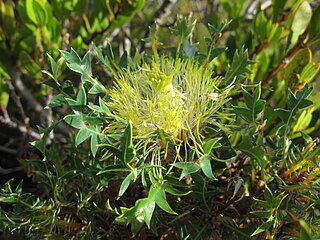
The torrent duck is a member of the duck, goose and swan family Anatidae. It is the only member of the genus Merganetta. It is placed in the shelduck subfamily Tadorninae after the "perching duck" assemblage to which it was formerly assigned was dissolved because it turned out to be paraphyletic.

Lujerului metro station, previously known as Armata Poporului is a metro station in the Militari neighborhood of Bucharest. It is located at the intersection of Lujerului and Iuliu Maniu Avenues, close to the Lujerului road-tunnel, near the Cotroceni Freight Railway Terminal, the Lujerului Silo, Mills and Bread Factory, and next to the Cora Lujerului hypermarket. The metro station also services the Plaza Romania mall.
As the number of German troops committed to the North African Campaign of World War II grew from the initial commitment of a small corps, the Germans developed a more elaborate command structure and placed the enlarged Afrika Korps, with Italian units under this new Italian and German command and a succession of commands were created to manage Axis forces in Africa:

The Chilean angelshark is an angelshark of the family Squatinidae found in the subtropical waters of Chile, that grows up to 1.03 metres in length. The holotype is lost. Reproduction is ovoviviparous.

Brahea armata, commonly known as Mexican blue palm or blue hesper palm, is a large evergreen tree of the palm family Arecaceae, endemic to Baja California, Mexico. It is widely planted as an ornamental.

Banksia armata, commonly known as prickly dryandra, is a species of often sprawling shrub that is endemic to Western Australia. It has deeply serrated leaves with sharply pointed lobes and spikes of about 45 to 70 yellow flowers.

Banksia armata var. armata is a variety of shrub that is endemic to Western Australia. It differs from the other variety in having a lignotuber, narrower leaves with more side lobes and shorter flowers. It is also usually a shorter plant.

Banksia armata var. ignicida is a variety of shrub that is endemic to Western Australia. It differs from the autonym in not having a lignotuber. It is also usually a taller plant with leaves that are longer with fewer side lobes, and longer flowers.
The 8th Army was a field army of the Royal Italian Army, which fought in World War I and on the Eastern Front during World War II.

Mauritiella is a dioecious genus of flowering plant in the palm family found in South America where it is commonly called buriti. It is named after the similar and closely related genus Mauritia.

Asparagopsis armata is a species of marine red algae, in the family Bonnemaisoniaceae. English name(s) include red harpoon weed. They are multicellular eukaryotic organisms. This species was first described in 1855 by Harvey, an Irish botanist who found the algae on the Western Australian coast. A. armata usually develops on infralittoral rocky bottoms around the seawater surface to around 40m of depth. Marine algae like A. armata are considered "autogenic ecosystem engineers" as they are at the very bottom of the food chain and control resource availability to other organisms in the ecosystem.

Vasile Bătrânac is a Moldovan former educator and early Soviet dissident who was the head of the Arcașii lui Ștefan group in the Moldavian Soviet Socialist Republic shortly after World War II.
Armata Neagră was an organized anti-Soviet group in the Moldovan SSR (Bessarabia).

The "Armata" Universal Combat Platform is a Russian advanced next generation modular heavy military tracked vehicle platform. The Armata platform is the basis of the T-14, the T-15, a combat engineering vehicle, an armoured recovery vehicle, a heavy armoured personnel carrier, a tank support combat vehicle, and several types of self-propelled artillery, including the 2S35 Koalitsiya-SV under the same codename based on the same chassis. It is also intended to serve as the basis for artillery, air defense, and NBC defense systems. The new "Armata" tank platform is meant to replace the older Russian main battle tanks and APCs that are currently used by the Russian military.

The VPK-7829 Bumerang is a modular amphibious wheeled infantry fighting vehicle and armored personnel carrier being developed by Russian Military Industrial Company (MIC) for the Russian army.

Pterolophia is a genus of longhorn beetles of the subfamily Lamiinae, containing the following species:

The T-14Armata is a Russian main battle tank (MBT) based on the Armata Universal Combat Platform.

The T-15 Armata, with industrial designation "Object 149", is a Russian heavy infantry fighting vehicle first seen in public in 2015 during rehearsals for the Moscow Victory Day Parade. The T-15 concept of a heavy IFV is derived from design of the BTR-T vehicle that never entered military service. As of May 2023, the T-15 Armata has not entered service and the program status is unknown.
Plebeina armata, the mopane bee or mopane fly, is a very small gnat-like stingless bee species native to Africa, and the only member of its genus. It lives in savannah of Senegal, Nigeria, Cameroun, D.R. Congo (Shaba), Rwanda, Uganda, Kenya, Zimbabwe, Angola, Botswana, South Africa and Namibia.













